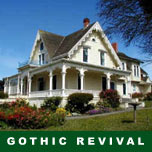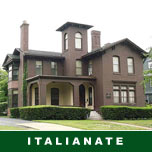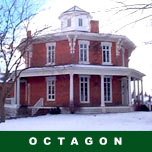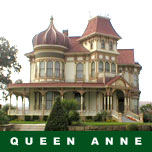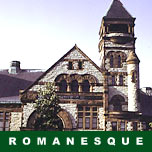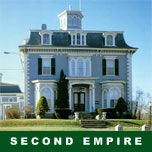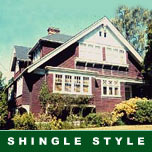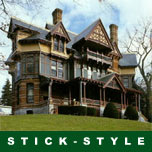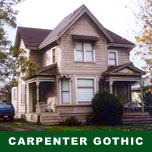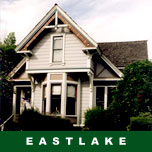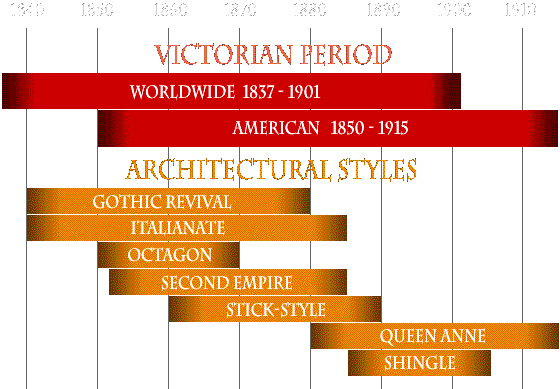
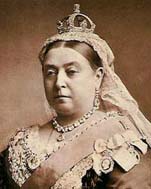

ueen Victoria was just eighteen when she took the crown in 1837. She reigned over
England with unparalleled enthusiasm and vigor for sixty-four years until
her death in 1901.
The style named after this beloved monarch is not
a style at all, but rather a procession of largely unrelated styles popularized
during the Victorian Era.
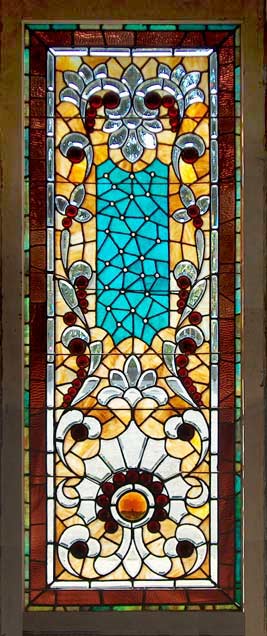
It would have been an electrifying time to be alive. As the Industrial Revolution gained momentum nothing could stand in its way. Every segment of Western Culture witnessed mind-numbing changes during the 19th century. The standards for socioeconomic stratification were thrown into the blender. Common people were able to afford goods that were previously beyond their reach. The fast paced technological and economic revolution brought with it the most inventive period in human existence. Available were sophisticated new machines, the fuel to power them, ample natural resources, and throngs of willing workers.
 For the first time, an emerging middle class entered the ranks of homeownership.
Better income made this possible, but equally important was the fact that
building materials such as glass and lumber became cheaper. In addition, “balloon-framing,” a
new method of construction, allowed faster and less costly home building.
New advances in steam shipping and rail transport made the world smaller.
An innovative spirit prevailed throughout the Victorian Era. This led to
inventions that changed the world such as the telegraph, electricly powered
homes,
electric lighting, and the telephone.
For the first time, an emerging middle class entered the ranks of homeownership.
Better income made this possible, but equally important was the fact that
building materials such as glass and lumber became cheaper. In addition, “balloon-framing,” a
new method of construction, allowed faster and less costly home building.
New advances in steam shipping and rail transport made the world smaller.
An innovative spirit prevailed throughout the Victorian Era. This led to
inventions that changed the world such as the telegraph, electricly powered
homes,
electric lighting, and the telephone.
Since Western Civilization was being made anew, it seemed appropriate to replace the long-standing styles of popular design. The Victorian aesthetic inclination was to revolt; thus, there developed a broad sweeping rejection of the traditional styles, tastes and attitudes toward all of the decorative arts. As the Industrial Age redefined all levels of society throughout Europe and America, the time was right for these bold changes. Queen Victoria open-mindedly fostered change and artistic exploration. On the other side of the Atlantic, American artists and architects exuberantly responded by developing American-Victorian designs and interpretations. In America there were no imposing historical restraints to constrict modern design exploration. Freedom of choice and unrestrained personal expression were championed as part of America’s coming of age. This atmosphere proved to be the perfect incubator for developing a delightfully uninhibited and diverse variety of American-Victorian homes, as well as their spectacular stained glass windows.
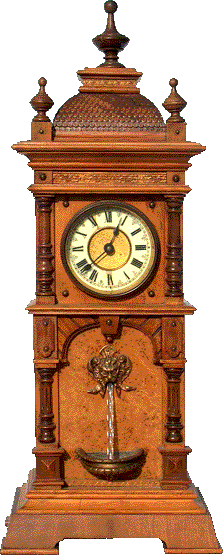 The styles that became popular during the Victorian era were as numerous
as they were diverse. A sampling of the architectural design “movements” that
were either created or re-created includes: Stick Style, Italianate, Octagon,
Queen Anne, Eastlake, Gothic Revival, Exotic Revival, Richardson Romanesque,
Carpenter Gothic, Second Empire, and Shingle.
The styles that became popular during the Victorian era were as numerous
as they were diverse. A sampling of the architectural design “movements” that
were either created or re-created includes: Stick Style, Italianate, Octagon,
Queen Anne, Eastlake, Gothic Revival, Exotic Revival, Richardson Romanesque,
Carpenter Gothic, Second Empire, and Shingle.
A steady stream of new books written by art critics, promoters, and chroniclers dealt with the ever-more-complex fields of architecture and decorative arts. Many of these books contained practical and insightful opinions. Others put forth quirky and humorous advice. Judging by the tremendous literary output, the public was most assuredly interested! In Orson Fowler’s mid-century book, “The Octagon House: A Home for All,” logical arguments were advanced that an eight-sided house would provide better sunlight, heat, ventilation, and room-to-room communication while eliminating dark corners. His book and subsequently, octagonal homes, were popular for the twenty years from 1850 to 1870. In his remarkably successful 1868 book, “Hints on Household Taste,” Charles L. Eastlake attempted to high-handedly demystify the principals of home furnishing and decorating for all the world. John Ruskin garnered a wide Victorian audience with his 1848 philosophically-presented “The Seven Lamps of Architecture,” in which he praised the beautiful forms in nature as well as some time honored styles. Ruskin’s next work, “The Stones of Venice,” explored the merits of medieval architecture and, thus, contributed to the creation of the Gothic Revival movement on both sides of the Atlantic. Also influential were Andrew Jackson Downing’s books: “Victorian Cottage Residences” and “The Architecture of Country Houses.” Owen Jones delivered an amzingly rich folio of decorative motifs from important ancient cultures such as Assyrian, Egyptian, Byzantine, Celtic, Turkish, and so on in his 1856 “The Grammar of Ornament,” which proved to further stimulate design diversity.
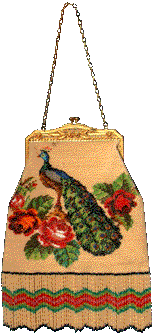 Some of the influential American architects of the period were Frank Furness,
Leon Marcotte, Stanford White, Louis Sullivan, Henry
Hobson Richardson, Ogden
Codman, Charles F. McKim, Richard Morris Hunt, Robert Swain Peabody, John
Goddard Stearns, John Russell Pope, George Brown Post, Horace Trumbauer,
and Daniel H. Burnham.
Some of the influential American architects of the period were Frank Furness,
Leon Marcotte, Stanford White, Louis Sullivan, Henry
Hobson Richardson, Ogden
Codman, Charles F. McKim, Richard Morris Hunt, Robert Swain Peabody, John
Goddard Stearns, John Russell Pope, George Brown Post, Horace Trumbauer,
and Daniel H. Burnham.
When thinking of the Victorian style, Americans readily picture the elaborately-ornamented, brightly-painted homes of San Francisco, each of which is categorized using different style names such as Queen Anne, Stick, or Italianate. These individually named styles can legitimately be called Victorian since their existence took place specifically during the Victorian Period. But it must be understood that here was no absolute style instruction manual published in England or in America to guide to way. Some of the most recognizable Victorian styles borrowed from the designs of earlier cultures, essentially recycling Greek (Greek Revival), Roman (Neo-Classical), Medieval (Gothic Revival), Egyptian (Egyptian Revival), Elizabethan (Renaissance Revival), and so on. Just as the style choices multiplied over the Victorian years, so did the mixing and matching of the components of the various styles. During the last quarter of the 19th century, the most ornate, imaginative, and colorful houses took shape in America. Some of which, for example, combined elements of Italianate, Stick-Style, Gothic, and Queen Anne all in a single residence!
